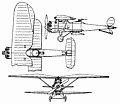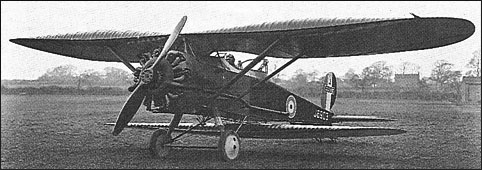|
| During construction of the Bullfinch prototypes, it was
decided to complete the third aeroplane as a two-seat
fighter biplane, and this, the Bullfinch II, was first flown
on 15 February 1924. The Bullfinch II differed from the
single-seat model primarily in having a 91.4cm
section housing a self-contained gunner's cockpit inserted
in the fuselage immediately aft of the pilot's
cockpit and beneath which was attached a cantilever
lower wing, the resultant shift of the centre of pressure
compensating for the change in the CG. The only other
change consisted of the repositioning of the main
undercarriage members farther aft. The rear cockpit
was fitted with a Scarff-mounted 7.7mm
Lewis gun, and structural weight was increased by
145kg. The 425hp Jupiter III engine was insufficiently
powerful to cater for the additional 400kg of the two-seater in fully loaded condition and
the performance of the Bullfinch II suffered in consequence.
 | A three-view drawing (800 x 693) |
| WEIGHTS |
| Take-off weight | 1854 kg | 4087 lb |
| Empty weight | 1132 kg | 2496 lb |
| DIMENSIONS |
| Wingspan | 11.71 m | 38 ft 5 in |
| Length | 8.38 m | 28 ft 6 in |
| Height | 3.28 m | 11 ft 9 in |
| Wing area | 36.32 m2 | 390.94 sq ft |
| PERFORMANCE |
| Max. speed | 193 km/h | 120 mph |
|
Do you have any comments?
|
| 
COMPANY
PROFILE
All the World's Rotorcraft
|







